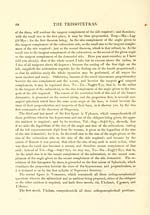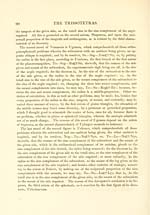Maitland Club > Works of Sir Thomas Urquhart
(131) Page 89
Download files
Complete book:
Individual page:
Thumbnail gallery: Grid view | List view

THE TRISSOTETRAS. S9
wherein the subtendent, and one including side being given, the interjacent angle is
demanded, and by its resolver Meg — Torp — Mu(£f=Nir, or because of the totall sines
mean proportion betwixt the tangent, and tangent complement, Torp — Teg — Muft^"
Nir, which is the same in effect, sheweth, that, if from the summe of the logarithms
of the middle termes, which in the first analogy is the radius and tangent complement
of the subtendent, we subtract the tangent complement of the given ambient, or, in the
second order of proportionals, joyne the tangent of the side given to the tangent com-
plement of the subtendent, and from the sum cut off the index, if need be, both will
tend to the same end, and produce, for the fourth proportionall, the sine complement
of the angle required ; for to subtract a tangent complement from the radius, and an-
other number joyned together, whether that tangent complement be more or lesse then
the radius, it is all one as if you should subtract the radius from the said tangent com-
plement and that other number ; because the tangent, or rather logarithm of the tan-
gent, (for so it must be alwayes understood, and not onely in tangents, but in sines,
secants, sides, and angles, though for brevity sake the word logarithm be oftentimes
omitted,) because, I say, the logarithms of the tangent and tangent complement to-
gether being the double of the radius, if first the tangent complement surpasse the
radius, and be to be subtracted from it, and another number, it is all one as if from
the said number you would abstract the radius and the tangent complement's excesse
above it, so that the radius being in both, there will remaine a tangent with the other
number. Likewise, if a tangent complement lesse then the radius be to be subtracted
from the summe of the radius and another logarithm, it is yet all one as if you had sub-
tracted the radius from the same summe ; because, though that tangent complement
be lesse then the radius, yet that parcell of the radius which was abstracted more then
enough, is recompensed in the logarithm of the tangent to be joyned with the other
number ; for, from which soever of the tangents the radius be subduced, its antitan-
gent is remainder ; both which cases may be thus illustrated in numbers; and first,
where the tangent complement is greater then the radius, as in these numbers, 6, 4,
3, 1, and 4, 2, 3, 1, where let 6 be the tangent complement, 4 the radius, 3 the
number to be joyned with the radius or either of the tangents, and 1 the remainer ;
for 4 and 3 making 7, if you abstract 6 there will remaine 1 . Likewise 2 and 3 mak-
ing 5, if you subtract 4 there will remaine 1. Next, if the tangent complement be
lesse then the radius, as in 2, 4, 3, 5, and 4, 6, 3, and 5, where let 2 be the tangent
complement ; for if from 4 and 3 joyned together you abstract 2, there will remaine
5, which will also be the remainder when you substract 4 from C and 3 added toge-
ther. Now, to make the same resolver, the variety whereof I have been so large in
explaining, to runne altogether upon tangents, instead of Meg — To — Mu{f3=Nir,
that is, As the tangent complement of the side given is to the totall sine, so the tan-
gent complement of the subtendent side to the sine complement of the angle required,
we may say, Tu — Teg — Tof^Nir ; that is, As the tangent of the subtendent is to
M
wherein the subtendent, and one including side being given, the interjacent angle is
demanded, and by its resolver Meg — Torp — Mu(£f=Nir, or because of the totall sines
mean proportion betwixt the tangent, and tangent complement, Torp — Teg — Muft^"
Nir, which is the same in effect, sheweth, that, if from the summe of the logarithms
of the middle termes, which in the first analogy is the radius and tangent complement
of the subtendent, we subtract the tangent complement of the given ambient, or, in the
second order of proportionals, joyne the tangent of the side given to the tangent com-
plement of the subtendent, and from the sum cut off the index, if need be, both will
tend to the same end, and produce, for the fourth proportionall, the sine complement
of the angle required ; for to subtract a tangent complement from the radius, and an-
other number joyned together, whether that tangent complement be more or lesse then
the radius, it is all one as if you should subtract the radius from the said tangent com-
plement and that other number ; because the tangent, or rather logarithm of the tan-
gent, (for so it must be alwayes understood, and not onely in tangents, but in sines,
secants, sides, and angles, though for brevity sake the word logarithm be oftentimes
omitted,) because, I say, the logarithms of the tangent and tangent complement to-
gether being the double of the radius, if first the tangent complement surpasse the
radius, and be to be subtracted from it, and another number, it is all one as if from
the said number you would abstract the radius and the tangent complement's excesse
above it, so that the radius being in both, there will remaine a tangent with the other
number. Likewise, if a tangent complement lesse then the radius be to be subtracted
from the summe of the radius and another logarithm, it is yet all one as if you had sub-
tracted the radius from the same summe ; because, though that tangent complement
be lesse then the radius, yet that parcell of the radius which was abstracted more then
enough, is recompensed in the logarithm of the tangent to be joyned with the other
number ; for, from which soever of the tangents the radius be subduced, its antitan-
gent is remainder ; both which cases may be thus illustrated in numbers; and first,
where the tangent complement is greater then the radius, as in these numbers, 6, 4,
3, 1, and 4, 2, 3, 1, where let 6 be the tangent complement, 4 the radius, 3 the
number to be joyned with the radius or either of the tangents, and 1 the remainer ;
for 4 and 3 making 7, if you abstract 6 there will remaine 1 . Likewise 2 and 3 mak-
ing 5, if you subtract 4 there will remaine 1. Next, if the tangent complement be
lesse then the radius, as in 2, 4, 3, 5, and 4, 6, 3, and 5, where let 2 be the tangent
complement ; for if from 4 and 3 joyned together you abstract 2, there will remaine
5, which will also be the remainder when you substract 4 from C and 3 added toge-
ther. Now, to make the same resolver, the variety whereof I have been so large in
explaining, to runne altogether upon tangents, instead of Meg — To — Mu{f3=Nir,
that is, As the tangent complement of the side given is to the totall sine, so the tan-
gent complement of the subtendent side to the sine complement of the angle required,
we may say, Tu — Teg — Tof^Nir ; that is, As the tangent of the subtendent is to
M
Set display mode to: Large image | Transcription
Images and transcriptions on this page, including medium image downloads, may be used under the Creative Commons Attribution 4.0 International Licence unless otherwise stated. ![]()
| Publications by Scottish clubs > Maitland Club > Works of Sir Thomas Urquhart > (131) Page 89 |
|---|
| Permanent URL | https://digital.nls.uk/82500693 |
|---|

